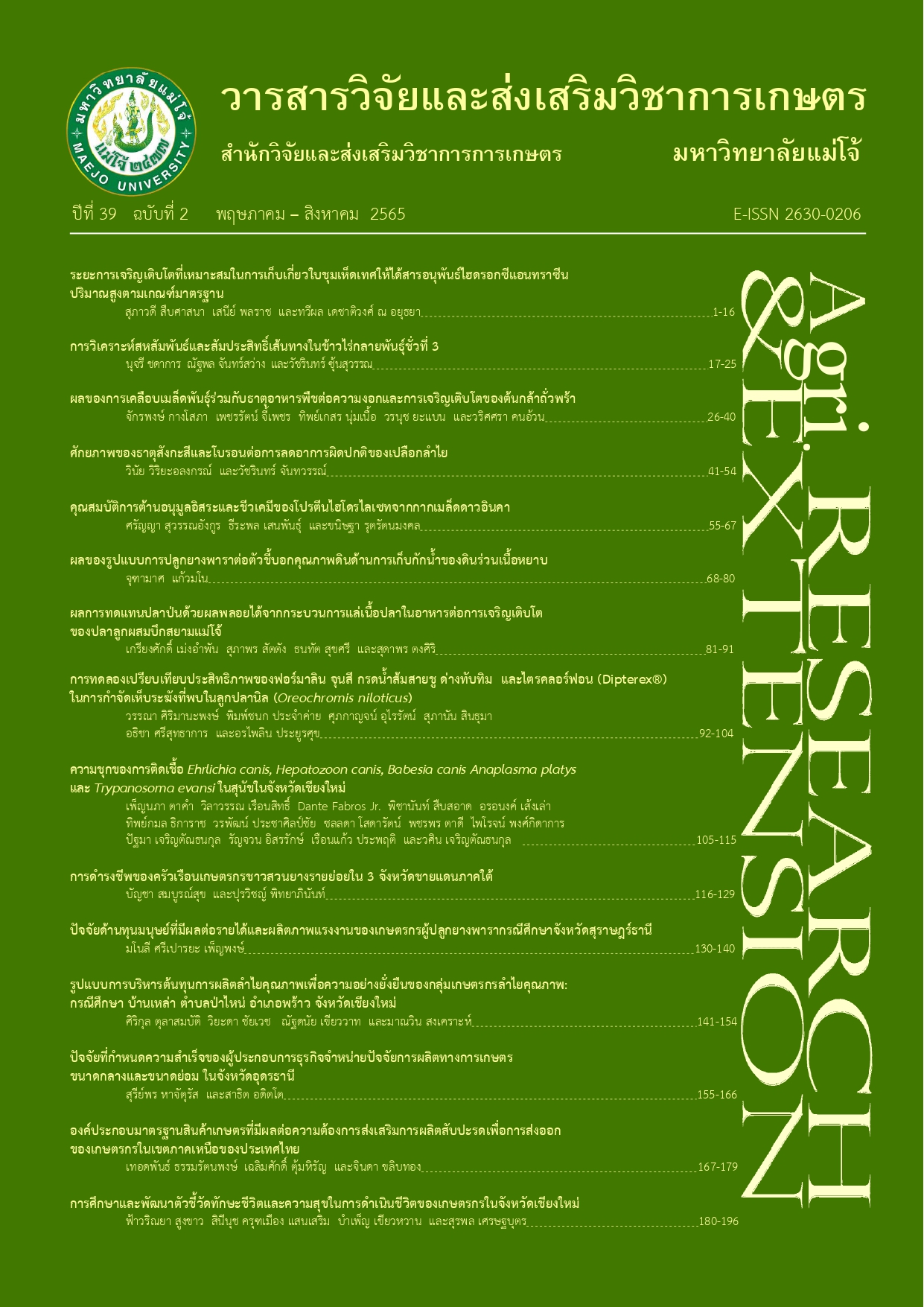คุณสมบัติการต้านอนุมูลอิสระและชีวเคมีของโปรตีนไฮโดรไลเซทจากกากเมล็ดดาวอินคา
คำสำคัญ:
กากเมล็ดดาวอินคา, โปรตีนไฮโดรไลเซท, สมบัติต้านอนุมูลอิสระ, เปปไทด์ที่มีฤทธิ์ทางชีวภาพบทคัดย่อ
น้ำมันจากเมล็ดดาวอินคาเป็นหนึ่งในน้ำมัน ที่คนนิยมรับประทาน โดยเฉพาะอย่างยิ่งผู้ที่รักสุขภาพ เนื่องจากภายหลังการบีบน้ำมันจะได้ผลิตผลพลอยได้(กากเมล็ดดาวอินคา) ประมาณร้อยละ 50 ของปริมาณวัตถุดิบเริ่มต้น ซึ่งผลิตผลพลอยได้ดังกล่าวอุดมด้วยโปรตีนที่มีคุณภาพ เหมาะสำหรับผลิตโปรตีนไฮโดรไลเซทและเปปไทด์ ที่มีประสิทธิภาพในการออกฤทธิ์ทางชีวภาพ ดังนั้นงานวิจัยนี้จึงมีวัตถุประสงค์ผลิตโปรตีนไฮโดรไลเซทและเปปไทด์ที่มีคุณสมบัติต้านอนุมูลอิสระและออกฤทธิ์ทางชีวเคมีในการยับยั้งเอนไซม์ที่เกี่ยวข้องกับการเกิดโรคเรื้อรัง เพื่อเพิ่มมูลค่าผลิตผลพลอยได้จากกากเมล็ด ดาวอินคา โปรตีนไฮโดรไลเซทถูกเตรียมจากกากเมล็ดดาวอินคาย่อยด้วยเอนไซม์ฟลาโวไซม์ จากนั้นโปรตีนไฮโดรไลเซท (SPH) ถูกกรองผ่านเยื่อกรองเมมเบรนระดับอัลตราฟิลเตรชันขนาด 1, 3, 5 และ 10 กิโลดาลตัน พบว่าเปปไทด์ขนาดต่ำกว่า 1 กิโลดาลตัน สามารถกำจัดอนุมูลอิสระ DPPH และอนุมูลไฮดรอกซิลสูงสุดอย่างมีนัยสำคัญ (p<0.05) เมื่อเปรียบเทียบกับเปปไทด์ที่มีขนาดใหญ่ อาจเนื่องจากพบกรดอะมิโนที่ไม่ชอบน้ำและกรดอะมิโน อะโรมาติกอยู่จำนวนมาก ทั้งนี้ SPH และเปปไทด์ มีความสามารถดักจับอิออนของโลหะได้ดีกว่าเมื่อเปรียบเทียบกับกลูตาไธโอน นอกจากนี้เปปไทด์ขนาดต่ำกว่า 1 กิโลดาลตัน มีบทบาทสำคัญในการยับยั้งเอนไซม์ ACE (โรคความดันโลหิตสูง) DPP-IV (โรคเบาหวานชนิดที่ 2) α-amylase และ α-glucosidase (โรคอ้วน) มีค่า IC50 เท่ากับ 1.56 2.31 3.77 และ 1.84 มก./มล. ตามลำดับ อย่างไรก็ตามกิจกรรมการต้านอนุมูลอิสระและการยับยั้งเอนไซม์ถูกกำหนดโดยน้ำหนักโมเลกุลและกรดอะมิโน
เอกสารอ้างอิง
Adebiyi, A.P. and R.E. Aluko. 2011. Functional properties of protein fractions obtained from commercial yellow field pea (Pisum sativum L.) seed protein isolate. Food Chem. 128(4): 902-908.
Aluko, R.E. 2019. Food protein-derived renin-inhibitory peptides: in vitro and in vivo properties. J. Food Biochem. 43: e12648.
Awosika, T.O. and R.E. Aluko. 2019. Inhibition of the in vitro activities of α-amylase, α-glucosidase and pancreatic lipase by yellow field pea (Pisum sativum L.) protein hydrolysates. Int. J. Food Sci. Technol. 54(6): 2021-2034.
Barbana, C. and J.I. Boye. 2010. Angiotensin I-converting enzyme inhibitory activity of chickpea and pea protein hydrolysates. Food Res. Int. 43(6): 1642-1649.
Chirinos, R., R. Pedreschi and D. Campos. 2020. Enzyme-assisted hydrolysates from sacha inchi (Plukenetia volubilis) protein with in vitro antioxidant and antihypertensive properties. J. Food Process. Preserv. 44(12): e14969.
Connolly, A., M.B. O’Keeffe, C.O. Piggott, A.B. Nongonierma and R.J. FitzGerald. 2015. Generation and identification of angiotensin converting enzyme (ACE) inhibitory peptides from a brewers’ spent grain protein isolate. Food Chem. 176: 64-71.
Fasuan, T.O., S.O. Gbadamosi and T.O. Omobuwajo. 2018. Characterization of protein isolate from Sesamum indicum seed: In vitro protein digestibility, amino acid profile, and some functional properties. Food Sci. Nutr. 6(6): 1715-1723.
Foh, M.B.K., I. Amadou, B.M. Foh, M.T. Kamara and W. Xia. 2010. Functionality and antioxidant properties of tilapia (Oreochromis niloticus) as influenced by the degree of hydrolysis. Int. J. Mol. Sci. 11(4): 1851-1869.
Girgih, A.T., C.C. Udenigwe and R.E. Aluko. 2011. In vitro antioxidant properties of hemp seed (Cannabis sativa L.) protein hydrolysate fractions. J. Am. Oil Chem. Soc. 88(3): 381-389.
Han, R., J. Maycock, B.S. Murray and C. Boesch. 2019. Identification of angiotensin converting enzyme and dipeptidyl peptidase-IV inhibitory peptides derived from oilseed proteins using two integrated bioinformatic approaches. Food Res Int. 115: 283-291.
Jack, F.K. and I. Mona. 1966. The kinetics of the papain-catalyzed hydrolysis of esters of carbobenzoxyglycine evidence for an acyl-enzyme Intermediate. J. Biochem. 5(2): 783-791.
Jagersberger, J. 2013. Development of Novel Products on Basis of Sacha Inchi-Use of Press Cakes and Hulls. Austria: University of Vienna. 125 p.
Lan, V.T., K. Ito, M. Ohno, T. Motoyama, S. Ito and Y. Kawarasaki. 2015. Analyzing a dipeptide library to identify human dipeptidyl peptidase IV inhibitor. Food Chem. 175: 66-73.
Landry, J. and S. Delhaye. 1992. Simplified procedure for the determination of tryptophan of foods and feedstuffs from barytic hydrolysis. J. Agric. Food Chem. 40(5): 776-779.
Lepping, P., J. Delieu, R. Mellor, J.H.H. Williams, P.R. Hudson and C. Hunter-Lavin. 2011. Antipsychotic medication and oxidative cell stress: A systematic review. J. Clin. Psychiatry. 72(3): 273-285.
Malomo, S.A., J.O. John, A.T. Girgih and R.E. Aluko. 2015. Structural and antihypertensive properties of enzymatic hemp seed protein hydrolysates. Nutrients 7(9): 7616-7632.
Markwell, M.A.K., S.M. Haas, L.L. Bieber and N.E. Tolbert. 1978. A modification of the Lowry procedure to simplify protein determination in membrane and lipoprotein samples. Anal. Biochem. 87(1): 206-210.
Maurer, N.E., B. Hatta-Sakoda, G. Pascual-Chagman and L.E. Rodriguez-Saona. 2012. Characterization and authentication of a novel vegetable source of omega-3 fatty acids, sacha inchi (Plukenetia volubilis L.) oil. Food Chem. 134(2): 1173-1180.
Parrado, J., F. Millan, I. Hernandez-Pinzon, J. Bautista and A. Machado. 1993. Characterization of enzymatic sunflower protein hydrolyzates. J. Agric. Food Chem. 41(11): 1821-1825.
Saiga, A., S. Tanabe and T. Nishimura. 2003. Antioxidant activity of peptides obtained from porcine myofibrillar proteins by protease treatment. J. Agric. Food Chem. 51(12): 3661-3667.
Santos, P.M., D.L.J. Batista, L.A.F. Ribeiro, E.F. Boffo, M.D. Cerqueira, D. Martins, R.D. Castro, L.C. Souza-Neta, E. Pinto, L. Zambotti-Villelae, P. Colepicoloe, L.G. Fernandez, G.A.B. Canuto and P.R. Ribeiro. 2018. Identification of antioxidant and antimicrobial compounds from the oilseed crop Ricinus communis using a multiplatform metabolite profiling approach. Ind. Crops Prod. 124(15): 834-844.
Sathe, S.K., H.H. Kshirsagar and G.M. Sharma. 2012. Solubilization, fractionation, and electrophoretic characterization of Inca peanut (Plukenetia volubilis L.) proteins. Plant Foods Hum. Nutr. 67(3): 247-255.
Theerakarunwong, P., P. Sanporkha, C. Hattakosol and N. Laohakulchit. 2021. Effect of flavozyme concentration and degradation time on chemical properties-physics of protein hydrolyzate from sacha inchi meal. Prawarun Agr. J. 18(2): 69-79. [in Thai]
Udenigwe, C.C. and R.E. Aluko. 2011. Chemometric analysis of the amino acid requirements of antioxidant food protein hydrolysates. Int. J. Mol. Sci. 12(5): 3148-3161.
Wang, S., F. Zhu and Y. Kakuda. 2018. Sacha inchi (Plukenetia volubilis L.): Nutritional composition, biological activity, and uses. Food Chem. 265: 316-328.
Zheng, L., Y. Zhao, C. Xiao, D. Sun-Waterhouse, M. Zhao and G. Su. 2015. Mechanism of the discrepancy in the enzymatic hydrolysis efficiency between defatted peanut flour and peanut protein isolate by flavorzyme. Food Chem. 168: 100-106.
ดาวน์โหลด
เผยแพร่แล้ว
รูปแบบการอ้างอิง
ฉบับ
ประเภทบทความ
สัญญาอนุญาต
ลิขสิทธิ์ (c) 2022 วารสารวิจัยและส่งเสริมวิชาการเกษตร

อนุญาตภายใต้เงื่อนไข Creative Commons Attribution-NonCommercial-NoDerivatives 4.0 International License.
บทความนี้ได้รับการเผยแพร่ภายใต้สัญญาอนุญาต Creative Commons Attribution-NonCommercial-NoDerivatives 4.0 International (CC BY-NC-ND 4.0) ซึ่งอนุญาตให้ผู้อื่นสามารถแชร์บทความได้โดยให้เครดิตผู้เขียนและห้ามนำไปใช้เพื่อการค้าหรือดัดแปลง หากต้องการใช้งานซ้ำในลักษณะอื่น ๆ หรือการเผยแพร่ซ้ำ จำเป็นต้องได้รับอนุญาตจากวารสาร





